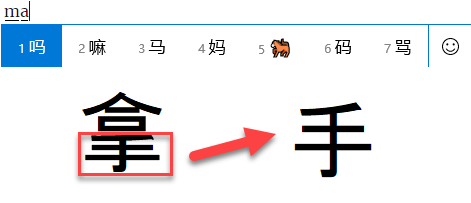Radicals can help to identify correct characters

In a previous post, I mentioned that radicals (characters within characters) can help you to recognize characters in Chinese.
A simple example is that if I type “ma” into my pin-yin editor, I see this:

The third character is the word for a horse. (Notice that it now even returns an emoticon for a horse in this editor as the fifth character -> how cute).
If you look at the fourth character, you can see the horse on the right, but another symbol on the left. The one on the left is the woman radical. I know this is the word for mother because this radical is there.
If you look at the first character, you’ll again see the horse on the right. That’s how the sound is assigned to the character. The radical on the left though is the character for a mouth. This “ma” is a bit like a question mark in English. Adding it to many sentences turns them into questions, like “ka” does in Japanese.
Another purpose
But there is another aspect of the radicals that makes them useful. In English, I could say:
I must bring an umbrella.
but I could also say:
I must take an umbrella.
You’ll notice there’s a subtle difference in the meaning of these English sentences, but they’re still pretty close.
Similarly, in Chinese there is often a confusion about whether to use
带 (Dài) - as a verb, Google says “carry”
or
拿 (Ná) - as a verb, Google says “take” or “hold”
Where the radicals become of interest, is helping to decide which one to use. Here is a bigger picture of the second word:

The bottom radical (that I have highlighted) is actually this character:
手 (Shǒu) which means “hand”
And it’s no surprise that 拿 (Ná) is more commonly related to situations where you are picking something up to take it (i.e. it involves using your hand).
2019-07-05
